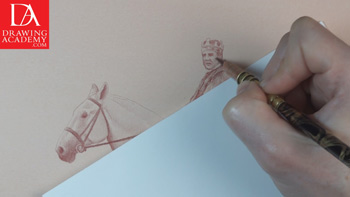Discover How to Draw Clothes
Video Lesson Description
In this video lesson, you will discover How to Draw Clothes on example of the horseman’s outfit.
How to Draw Clothes
Sometimes, art students ask me how to draw clothes and drapery folds. This topic becomes quite important when drawing a dressed human figure.
When it comes to the topic of How to Draw Clothes, the main thing to remember is that drapery or cloth is just that; there is a human body underneath it, so the drapery will take the form of the human body and the excess material will form the folds.
How to Draw Clothes – Folds Formation
When you consider how to draw clothes, keep in mind that the folds formation depends on the direction of forces applied to the cloth. There are actually a very limited number of typical folds. All drapery folds can be broadly classified into three groups. As soon as the fine artist has a clear understanding of those folds groups, drapery drawing becomes a much easier task. I will reveal those folds types in few minutes.
Many of the Old Masters spent a great deal of time studying how to draw clothes. There are many drawings left by Leonardo da Vinci, Albrecht Durer, Raphael, Michelangelo and many others fine artists where human anatomy under the drapery is apparent.
When considering ‘how to draw clothes’, the depiction of drapery became a fundamental question in the drawing of the clothed human figure. Fine artists discovered the possibilities of capturing movement and volume of folds. They made the drapery folds a part of the composition and were exploring the light and shade effects, which portrayed the texture and material of cloth.
Since that time not every art movement favored a realistic depiction of drapery folds. Starting from Impressionism, it became almost good taste to draw folds badly.
However, if your ambition is to learn how to draw clothes realistically, then the knowledge of the correlation between human figure anatomy and drapery folds will be helpful.
Here is what Leonardo da Vinci wrote on this topic in his notebook.
“Every thing, by nature, tends to remain at rest. Drapery, being of equal density and thickness on its wrong side and on its right, has a tendency to lie flat; therefore, when you give it a fold or plait forcing it out of its flatness, note well the result of the constraint in the part where it is most confined; and the part which is farthest from this constraint you will see relapses most into the natural state; that is to say, lies free and flowing.”
“You ought not to give to drapery a great confusion of many folds, but rather only introduce them where they are held by the hands or the arms; the rest you may let fall simply where it is its nature to flow.”
Leonardo classifies folds as follows:
1. Folds with kinks, which are characteristic to rigid draperies.
2. Folds with soft curves characteristic to silk and other soft thin materials.
3. Heavy folds that are formed on thick draperies.
As we can see, he groups folds according to the material’s characteristics.
Folds also can be classified on a basis of the direction of forces applied to the cloth:
1. Straight cylindrical folds that are formed by parallel forces.
2. Diagonal folds that are formed by the forces pulled at two points in opposite directions.
3. Radial folds when a cloth is pulled at one point perpendicularly to the drapery surface.
This information about folds is applicable to many more cases apart from drapery or cloth.
To finish the story on “how to draw clothes”, I have to say that most modern clothes are designed as tubes – jackets, socks, sleeves, trousers, skirts, shirts and so on. So forces that create folds are often going around the cylindrical shapes. Both classifications by Leonardo and in accordance to the forces’ directions are very much applicable here.
Elasticity and thickness of the material very much influence the form of the folds, while directions of forces characterize their shape.
The knowledge of folds formation will help you understand the nature of folds and their various characteristics.
Keep practicing quick colored pencil drawings. They can be very illustratively stylized and realistic at the same time.
Good drawing skills come with practice. Observe nature and draw daily.
- Receive 15 new videos monthly (45 in total)
- Incredible discount – $4,164
- Bonuses - Fine Art eBooks and Videos
- Drawing Academy Diploma of Excellence after course completion in 3 months
- Personal coaching by Drawing Academy Tutors
- Lifetime membership. Free after the 3rd month
- Immediate access to all 45 video lessons
- Incredible discount – $4,198
- Bonuses - Fine Art eBooks and Videos
- Drawing Academy Diploma of Excellence after course completion in 3 months
- Personal coaching by Drawing Academy Tutors
- Lifetime membership. No more payments



